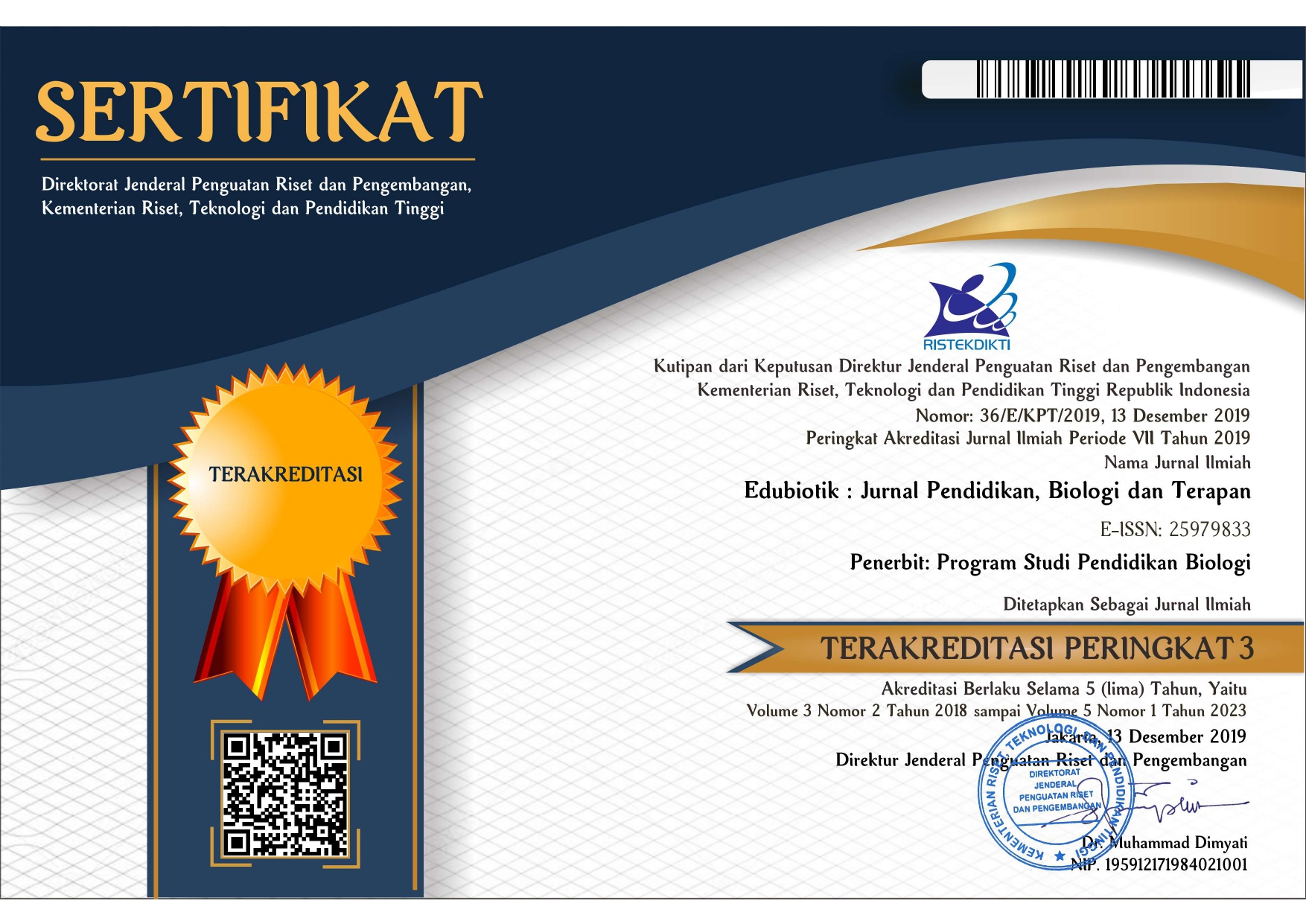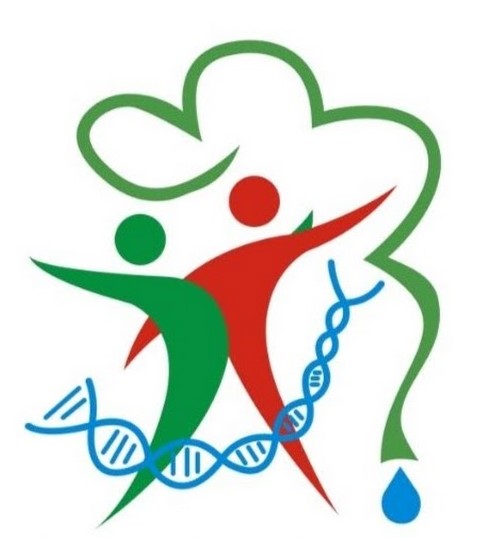Eugenia polyantha leaf extract as an antidiabetic alternative medicine on Rattus norvegicus
Abstract
The public does not yet know the potential of Eugenia polyantha as an alternative medicine for diabetes mellitus. In fact, the content of chemical compounds such as flavonoids in Eugenia polyantha can minimize damage to the pancreas. This study aimed to determine the antidiabetic activity of the ethanolic extract of Eugenia polyantha leaf against streptozotocin-induced Wistar rats. The sample for this study were male white rats of the Wistar strain, consisting of 30 rats. It was divided into 6 test groups, group P1 was negative control (aqua dest), group P2 was positive control (glibenclamide), and group P3, P4, and P5 was treated with 70% ethanol extract of Eugenia polyantha leaf with doses of 312.5, 625 and 1250 mg/kg respectively. The blood glucose level on the 11th day was tested by ANOVA which is then tested by Duncan. The results showed Eugenia polyantha leaf extract has an effect on reducing blood glucose in Wistar rats (Rattus norvegicus) with doses 312.5, 625, and 1250 mg/kg body weight. The most effective dose of 70% ethanol extract of Eugenia polyantha leaf for reducing blood glucose is 1250 mg/kg body weight. Furthermore, the findings of this study can be tested in more depth so that it can be recommended to the public as an alternative medicine for diabetes mellitus in humans.
References
Bahriul, P., Rahman, N., & Diah, A. W. M. (2014). Antioxidant activity test of bay leave (Syzygium polyanthum) extract using 1,1-diphenyl-2-picrilhidrazil. Jurnal Akademika Kimia, 3(3), 368–374. http://jurnal.untad.ac.id/jurnal/index.php/JAK/article/view/7794
Brahmachari, G. (2011). Bio-flavonoids with promising antidiabetic potentials: A critical survey. Research Signpost, 187-212. https://www.researchgate.net/
Firdausya, H., & Amalia, R. (2020). Aktivitas dan efektivitas antidiabetes pada beberapa tanaman herbal. Farmaka, 18(1), 162-170. https://jurnal.unpad.ac.id/farmaka/article/view/22467
Furman, B. L. 2015. Streptozotocin-induced diabetic models in mice and rats. Curr Protoc Pharmacol, 70:5.47.1-5.47.20. https://doi.org/10.1002/0471141755.ph0547s70
Hakim, Buraerah H., Abdullah, A., Zulkifli, Hanis, M. (2009). Analisis faktor risiko diabetes melitus tipe 2 di puskesmas Tanrutedong, Sidenreng Rappang, 2007. MEDIKA: Jurnal Kedokteran Indonesia, 35(4), 228-237. https://lib.atmajaya.ac.id/default.aspx?tabID=61&id=186192&src=a
Harismah, K., & Chusniatun. (2016). Pemanfaatan daun salam (Eugenia polyantha) sebagai obat herbal dan rempah penyedap makanan. WARTA LPM, 19(2), 110-118. https://journals.ums.ac.id/index.php/warta/article/view/2742
Jais, M., Tahlil, T., & Susanti, S. S. (2021). Dukungan keluarga dan kualitas hidup pasien diabetes mellitus yang berobat di puskesmas. Jurnal Keperawatan Silampari, 5(1), 82-88. https://doi.org/10.31539/jks.v5i1.2687
Kasole, R., Martin, H. D., & Kimiywe, J. (2019). Traditional medicine and its role in the management of diabetes mellitus: “Patients’ and herbalists’ perspectives”, 2019, 1-12. https://doi.org/10.1155/2019/2835691
Lee, J., Noh, S., Lim S., & Kim B. (2021). Plant extracts for type 2 diabetes: from traditional medicine to modern drug discovery. Antioxidants (Basel), 10(1), 81. https://doi.org/10.3390/antiox10010081
Lelono, R. A. A., & Tachibana, S. (2013). Preliminary studies of Indonesian Eugenia polyantha leaf extracts as inhibitors of key enzymes for type 2 diabetes. Journal of Medical Sciences, 13(2). https://scialert.net/abstract/?doi=jms.2013.103.110
Liu Y., Wang C., Li J., Mei Y., & Liang Y. (2019). Hypoglycemic and hypolipidemic effects of Phellinus linteus mycelial extract from solid-state culture in a rat model of type 2 diabetes. Nutrients, 11(2), 296. https://doi.org/10.3390/nu11020296
Mahendra, B., Krisnatuti, D., Tobing, A., & Alting, B. Z. A. (2018). Care Your Self Diabetes Mellitus. Penebar Plus, Jakarta. https://www.goodreads.com/book/show/13410036-care-yourself-diabetes-mellitus
Maliangkay, H. P., Rumondor, R., & Kantohe, M. 2019. Skrining fitokimia dan potensi antidiabetes ekstrak etanol herba ciplukan (Physalis Angulata L) pada tikus putih (Rattus Novergicus) yang diinduksi aloksan. BIO-EDU: Jurnal Pendidikan Biologi, 4(3), 98-107. https://doi.org/10.32938/jbe.v4i3.422
Man, S., Ma, J., Yao, J., Cui, J., Wang, C., Li, Y., Ma, L., & Lu, F. (2017). Systemic perturbations of key metabolites in type 2 diabetic rats treated by polyphenol extracts from litchi chinensis seeds. J. Agric. Food Chem, 65(35), 7698-7704. https://doi.org/10.1021/acs.jafc.7b02206
Marwati, M., & Amidi. (2018). Pengaruh budaya, persepsi, dan kepercayaan terhadap keputusan pembelian obat herbal. Jurnal Ilmu Manajemen, 7(2), 168-180. https://doi.org/10.32502/jimn.v7i2.1567
Munadjad, I. (2010). Health triad body, mind & system. PT. Elex Media Komputindo Kelompok Gramedia, Jakarta. https://books.google.co.id/
Putakala, M., Gujjala, S., Nukala, S., & Desireddy, S. (2017). Beneficial effects of Phyllanthus amarus against high fructose diet induced insulin resistance and hepatic oxidative stress in male wistar rats. Appl Biochem Biotechnol 183, 744–764 (2017). https://doi.org/10.1007/s12010-017-2461-0
Siregar, R. N. I. (2015). The effect of eugenia polyantha extract on LDL cholesterol. JURNAL MAJORITY, 4(5), 85-92. https://juke.kedokteran.unila.ac.id/index.php/majority/article/view/614
Saputra, N. T., Suartha, I. N., & Dharmayudha, A. A. G. O. (2018). Agen diabetagonik streptozotocin untuk membuat tikus putih jantan diabetes mellitus. Buletin Veteriner Udayana, 10(2), 116-121. https://doi.org/10.24843/bulvet.2018.v10.i02.p02
Simson, I. L., & Basuki, M. 2019. Uji aktifitas fraksi daun salam terhadap kadar glukosa darah tikus putih jantan hiperkolesteroemia diabetes. Farmakologika Jurnal Farmasi, 16(2), 116-125. https://jfarma.org/index.php/farmakologika/article/view/74
Suhendra, C. P., Widarta, I. W. R., & Wiadnyani, A. A. I. S. (2019). Pengaruh konsentrasi etanol terhadap aktivitas antioksidan ekstrak rimpang ilalang (Imperata Cylindrica (L) Beauv.) pada ekstraksi menggunakan gelombang ultrasonik. Jurnal Ilmu Dan Teknologi Pangan (ITEPA), 8(1), 27-35. https://doi.org/10.24843/itepa.2019.v08.i01.p04
Susanti, S., & Bistara, D. N. (2018). Hubungan pola makan dengan kadar gula darah pada penderita diabetes mellitus. Jurnal Kesehatan Vokasional, 3(1), 29-34. https://doi.org/10.22146/jkesvo.34080
Sutrisna, E. (2016). antidiabetic activity of ethanolic extract of Eugenia polyantha wight leaf from Indonesia in diabetic rat Wistar strain induced by alloxan. Asian Journal of Pharmaceutical and Clinical Research, 9(1), 374-376. https://journals.innovareacademics.in/index.php/ajpcr/article/view/7995
Yulianti, R., Simanjuntak, P., & Purba, A.V. 2020. Pengembangan sediaan serbuk antidiabetes dari kombinasi ekstrak kulit buah manggis (Garcinia mangostana L.) dan ekstrak daun salam (Syzygium polyanthum (Wight) Walp.). Jurnal Fitofarmaka Indonesia (JFFI), 7(1), 22-26. https://doi.org/10.33096/jffi.v7i1.593





.png)
2.png)

1.jpg)


